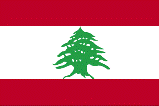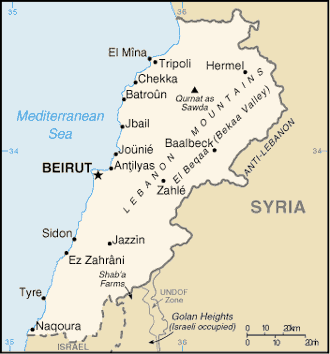|
Lebanon
|

|
Capital: Beirut
Population: 6,855,713
Brief History of Lebanon:
The land of Lebanon was settled thousands of years ago. The city of Byblos is one of the oldest continuously inhabited cities in the world.
Around 1500 BC the Empire of the Phoenicians emerged from the land of Lebanon. They were a seafaring people whose culture flourished and spread through the Mediterranean. The Phoenicians would stay in power until around 300 BC when the Persian Empire, led by Cyrus the Great, would conquer the land. The most famous Phoenician city was Tyre. Alexander the Great burned Tyre in 332 BC. Several more empires would control the land of Lebanon over history including the Romans, Arabs, and finally the Ottoman Empire.
When the Ottoman Empire collapsed after World War I, France took control of Lebanon. In 1943, Lebanon gained independence from France. Since independence Lebanon has been involved with wars with Israel as well as internal civil war.
The Geography of Lebanon
Total Size: 10,400 square km
Size Comparison: about 0.7 times the size of Connecticut
Geographical Coordinates: 33 50 N, 35 50 E
World Region or Continent: Middle East
General Terrain: narrow coastal plain; El Beqaa (Bekaa Valley) separates Lebanon and Anti-Lebanon Mountains
Geographical Low Point: Mediterranean Sea 0 m
Geographical High Point: Qurnat as Sawda' 3,088 m
Climate: Mediterranean; mild to cool, wet winters with hot, dry summers; Lebanon mountains experience heavy winter snows
Major cities: BEIRUT (capital) 1.909 million (2009), Tripoli, Sidon
The People of Lebanon
Type of Government: republic
Languages Spoken: Arabic (official), French, English, Armenian
Independence: 22 November 1943 (from League of Nations mandate under French administration)
National Holiday: Independence Day, 22 November (1943)
Nationality: Lebanese (singular and plural)
Religions: Muslim 59.7% (Shi'a, Sunni, Druze, Isma'ilite, Alawite or Nusayri), Christian 39% (Maronite Catholic, Greek Orthodox, Melkite Catholic, Armenian Orthodox, Syrian Catholic, Armenian Catholic, Syrian Orthodox, Roman Catholic, Chaldean, Assyrian, Copt, Protestant), other 1.3%
National Symbol: cedar tree
National Anthem or Song: Kulluna lil-watan (All Of Us, For Our Country!)
Economy of Lebanon
Major Industries: banking, tourism, food processing, jewelry, cement, textiles, mineral and chemical products, wood and furniture products, oil refining, metal fabricating
Agricultural Products: citrus, grapes, tomatoes, apples, vegetables, potatoes, olives, tobacco; sheep, goats
Natural Resources: limestone, iron ore, salt, water-surplus state in a water-deficit region, arable land
Major Exports: authentic jewelry, inorganic chemicals, miscellaneous consumer goods, fruit, tobacco, construction minerals, electric power machinery and switchgear, textile fibers, paper
Major Imports: petroleum products, cars, medicinal products, clothing, meat and live animals, consumer goods, paper, textile fabrics, tobacco
Currency: Lebanese pound (LBP)
National GDP: $61,440,000,000
** Source for population (2012 est.) and GDP (2011 est.) is CIA World Factbook.
Back to Geography Home Page
